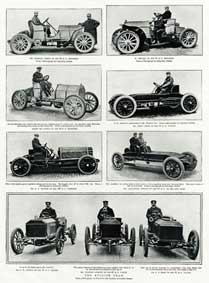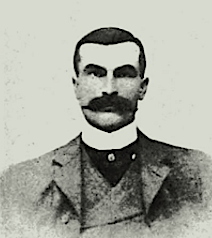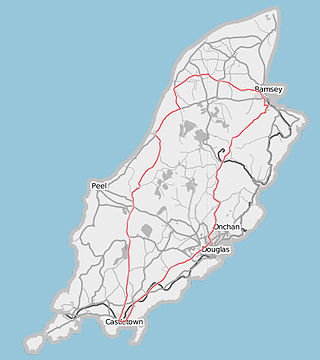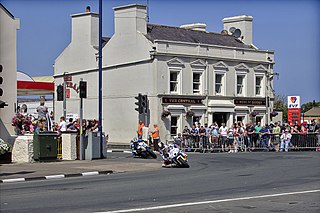
The Isle of Man TT or Tourist Trophy races are an annual motorcycle racing event run on the Isle of Man in May/June of most years since its inaugural race in 1907. The event is often called one of the most dangerous racing events in the world as many competitors have died.

D. Napier & Son Limited was a British engineering company best known for its luxury motor cars in the Edwardian era and for its aero engines throughout the early to mid-20th century.

As one of three Gordon Bennett Cups established by James Gordon Bennett, Jr., millionaire owner of the New York Herald, the automobile racing award was first given in 1900 in France.

Selwyn Francis Edge (1868–1940) was a British businessman, racing driver, cyclist and record-breaker. He is principally associated with selling and racing De Dion-Bouton, Gladiator; Clemént-Panhard, Napier and AC cars.

The 1906 Grand Prix de l'Automobile Club de France, commonly known as the 1906 French Grand Prix, was a motor race held on 26 and 27 June 1906, on closed public roads outside the city of Le Mans. The Grand Prix was organised by the Automobile Club de France (ACF) at the prompting of the French automobile industry as an alternative to the Gordon Bennett races, which limited each competing country's number of entries regardless of the size of its industry. France had the largest automobile industry in Europe at the time, and in an attempt to better reflect this the Grand Prix had no limit to the number of entries by any particular country. The ACF chose a 103.18-kilometre (64.11 mi) circuit, composed primarily of dust roads sealed with tar, which would be lapped six times on both days by each competitor, a combined race distance of 1,238.16 kilometres (769.36 mi). Lasting for more than 12 hours overall, the race was won by Ferenc Szisz driving for the Renault team. FIAT driver Felice Nazzaro finished second, and Albert Clément was third in a Clément-Bayard.

The Isle of Man TT Mountain Course or TT Course is a street and public rural road circuit located in the Isle of Man, used for motorcycle racing. The motorcycle TT Course is used principally for the Isle of Man TT Races and also the separate event of the Isle of Man Festival of Motorcycling for the Manx Grand Prix and Classic TT Races held in September of each year. The start-line for the Isle of Man TT Mountain Course is located on Glencrutchery Road in the town of Douglas, Isle of Man.

Dorothy Elizabeth Levitt was a British racing driver and journalist. She was the first British woman racing driver, holder of the world's first water speed record, the women's world land speed record holder, and an author. She was a pioneer of female independence and female motoring, and taught Queen Alexandra and the Royal Princesses how to drive. In 1905 she established the record for the longest drive achieved by a lady driver by driving a De Dion-Bouton from London to Liverpool and back over two days, receiving the soubriquets in the press of the Fastest Girl on Earth, and the Champion Lady Motorist of the World.
The St John's Short Course was a road-racing street circuit used for the Isle of Man TT held between 1907 and 1910.
The Verandah, Isle of Man is a series of four bends which motorcyclists negotiate at high speed during road racing on the Snaefell Mountain Course on the Isle of Man.

The RAC Tourist Trophy is a motor racing award presented by the Royal Automobile Club (RAC) to the overall victor of a motor race in the United Kingdom. Established in 1905, it is the world's oldest continuous motor race. The 18-carat gold trophy is based on Giambologna's sculpture of the Greek god Hermes. Series to have featured the trophy include the World Sportscar Championship, the FIA GT Cup, the World Touring Car Championship, the European Touring Car Championship, the FIA GT Championship, the British Touring Car Championship, the FIA GT1 World Championship, and the overall winners of the British GT Championship in the 1999, 2000, 2003 and 2004 seasons. It has been presented to the overall winners of the Silverstone Circuit round of the FIA World Endurance Championship from 2013 on.

Highroads Course was a road-racing circuit used for the Gordon Bennett British Eliminating Trial held in the Isle of Man for the 1904 and 1905 Tourist Trophy Race involving touring automobiles and cars. The events were held on public roads closed for racing by an Act of Tynwald.

Parliament Square, Ramsey is situated between the 23rd and 24th Milestone road-side markers on the Snaefell Mountain Course used for the Isle of Man TT Races on the junction of the primary A3 Castletown to Ramsey road, the A9 Ramsey to Andreas road and A2 Douglas to Ramsey road situated in the town of Ramsey in the parish of Lezayre in the Isle of Man.

Ballaugh Bridge is located on the primary A3 Castletown to Ramsey road and adjacent to the road junctions with the A10 Ballaugh to Ramsey coast road and the tertiary C37 Ballaugh Glen Road in the parish of Ballaugh in the Isle of Man.

Walter Thomas Clifford Earp (1879–1921) was a British pioneer racing motorist.

Douglas Road Corner or Kirk Michael Corner is situated adjacent the 14th Milestone road-side marker on the Snaefell Mountain Course on the primary A3 Castletown to Ramsey Road and the road junction with the A4 Peel to Kirk Michael Coast Road in the parish of Michael in the Isle of Man.
The 1902 Gordon Bennett Cup, formally titled the III Coupe Internationale, was a motor race held on 26–28 June 1902, on public roads between Paris, France, and Innsbruck, Austria. The race was held over a 565 km section of the route of the Paris-Vienna race, held concurrently. France were to attempt to defend the Gordon Bennett Cup against Britain, and each country was represented by three entries, with the car that finished the race in the shortest time winning the race on behalf of his country. Selwyn Edge driving a Napier, and representing the Automobile Club of Britain and Ireland, was the only competitor to finish the race and so Britain were the winners of the Gordon Bennett Cup and would be required to defend it in Britain the following year.

The 1903 Gordon Bennett Cup, formally titled the IV Coupe Internationale, was a motor race held on 2 July 1903, on the Athy Circuit consisting of closed roads in Ireland. The race consisted of seven laps - alternating for six laps over a shorter circuit to the west of Athy and longer circuit to the East, before a final lap on the longer circuit to make the total distance 527 km. A British entry had won the previous edition of the race, which meant that the rights to host the race fell to the Automobile Club of Britain and Ireland. Legislation was passed to allow the race to take place on roads in Ireland, then a part of the United Kingdom. Britain were to attempt to defend the Gordon Bennett Cup against France, Germany and the USA, and each country was represented by three entries, with the car that finished the race in the shortest time winning the race on behalf of his country.
Wolseley Racing consisted of a number of motor car racing efforts between 1903 and 1969 supported by Wolseley Motor Company which resulted in many victories and helped promote the brand and prowess of the company. In addition to the company-sponsored racing there were individuals who entered Wolseley cars or cars with Wolseley motors into races. The history of Wolseley Racing can be split into three periods matching the history of the automobile:
- The early days before World War I when the automotive industry and racing was in its infancy
- between the wars after production was switched from a war effort back to domestic products and the innovations of WW1 had been applied to engine technology and
- from after World War II to the present day.

William Watson was a Liverpool-born racing driver and motoring pioneer. A champion cyclist as a young man, he founded W Watson & Co, cycle and motorcar manufacturer, in 1901. He won the epic 1908 Isle of Man Tourist Trophy Race driving a Hutton-Napier named Little Dorrit. He also raced in Berliet, Vauxhall and Essex cars. He expanded Watson & Co from Liverpool to Chester, Colwyn Bay, London, Birkenhead and Crewe, creating the largest car distributing organisation in the North of England, specialising in Morris and Rolls-Royce cars.
The 1904 Gordon Bennett Cup, formally titled the V Coupe Internationale, was a motor race held on 17 June 1904 on the Homburg Circuit in Germany. The race consisted of four laps of the circuit to make the total distance 527 km. A German entry had won the previous year's edition of the race, which meant that the rights to host the race fell to the Automobilclub von Deutschland (AvD). Germany were to attempt to defend the Gordon Bennett Cup against France, Great Britain, Austria and Italy, and each country was represented by three entries, with the car that finished the race in the shortest time winning the race on behalf of his country.



















